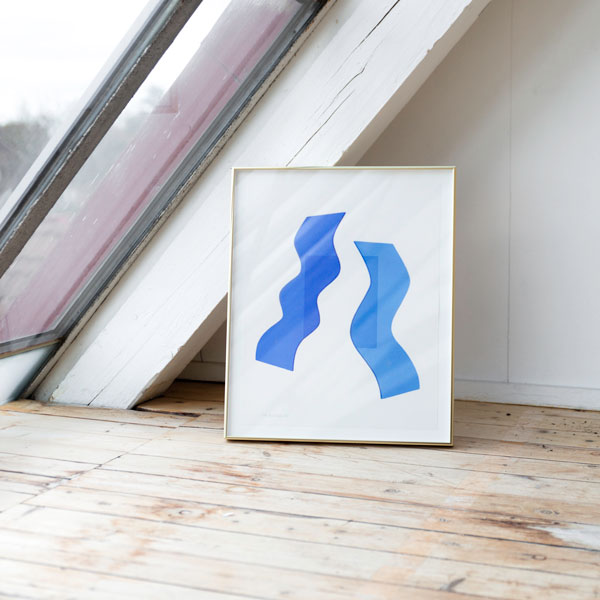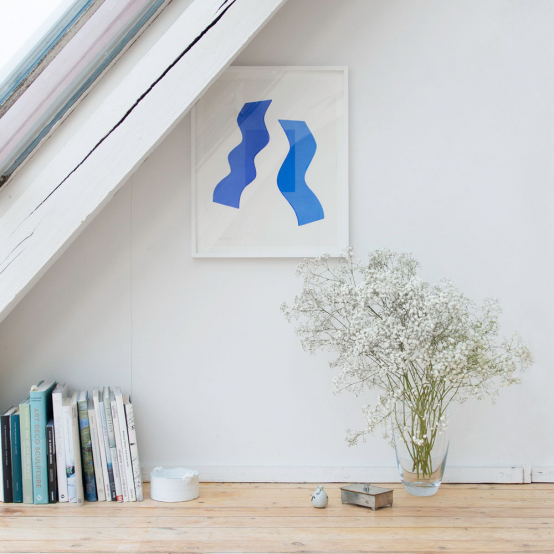above and beyond me

When we at Sveriges allmänna konstförening (SAK) and ed. art were to decide which artist we would ask to make our joint print edition, the choice was obvious: we wanted to work with Elin Odentia. She graduated from the Royal Institute of Art as late as in 2019, after studies there and at the University of Arts, Craft and Design in Stockholm, but she already feels like a given part of the Swedish art scene, with her very own mode of expression and very clear vision. Elin Odentia creates intricate shapes, works on colors and surfaces with meticulous accuracy. In the works there is a stillness and a calm, something to disappear into and meditate on.
And that calm is central to Odentia:
– The fact that painting can be an escape, a calm space, has always been important to me, as an antipole to a fast-paced, sometimes chaotic world. In the act of painting, but also in the finished works, I want there to be a stillness, a pause.
Elin Odentia worked with portrait painting for many years, but abandoned the figurative when starting her university level art studies.
– I got stuck in the story, "what person is this, what has happened, what will happen". I have always been more interested in a mood, what the painting says, how it behaves. The idea of the painting as a body or as a window. How colours behave next to each other. In some way the narrative became too obvious, the relation to painting was more abstract to me.
 The serigraph Above and beyond me
The serigraph Above and beyond me
But she does not completely think she has abandoned portraits. Some might call her pictures architectural, but Elin Odentia herself still sees them as some kind of portrait.
– I am interested in architecture, and above all spaciousness, but I think my paintings can also be seen as some kind of bodies, something that can turn away or confront you.
Elin Odentia works completely without models. The ideas for the paintings come to her as a sort of vision. In fact, she fends off the word idea.
– It sounds like I have been thinking and have come up with something. That is not the case. It is closer to a feeling. I'd rather call it visions, someone else would probably simply say inspiration. When I start working, it is based on a sense of urgency, or necessity. At that stage, I don’t know why a painting will look and behave in a certain way, but I know that it is essential that it should be created exactly like that. In this part of the process, it is important to trust the painting.
It sounds so easy, has it always been like that?
– No, it probably has something to do with the fact that I have learned to trust that feeling, I know that I will understand later. It feels uninteresting to question and more interesting to let it happen.
But does everything come as a vision? Is there not a movement from work to work? That you take an idea with you from one work to try in the next?
– Yes, that probably happens! If I look at old paintings, I see that there is a movement and a common thread. But it must happen on a different level of consciousness than thoughts, I often see it only later.
 Elin Odentia in front of one of the paintings shown at Cecilia Hillström gallery at the exhibition The Waves
Elin Odentia in front of one of the paintings shown at Cecilia Hillström gallery at the exhibition The Waves
In the serigraphy you made for SAK and ed. art there is a beautiful wave shape that one can recognize from the paintings in your solo exhibition the Waves at Cecilia Hillström Gallery just before Christmas.
– Yes, I have thought about those transparent fields that are often found in my works and I think they partly stem from veils that naked goddesses can wear on old paintings. The fabrics which they wear – just like my veils – is something that covers, but at the same time makes the bodies more visible. The nudity becomes even more obvious.
Has the work with serigraph differed from the work with a painting?
– I wanted to do something that was specific to prints, not a painting transferred to paper. I knew I wanted to work monochrome and let the color and surface of the paper be part of the work. I have thought a lot about how something very simple can feel so overwhelming and strong, like a color or a shape or a movement.
– The blue color has historically been considered sacred. For a long time, lapis lazuli, the stone which was used to make the color we today call ultramarine, was so expensive that it was used very seldom, if the client was rich enough. The Virgin Mary's clothes were often bright blue. During modernism, blue has often been talked of as the color of the soul, and also been ascribed holy properties. I guess it also has to do with the fact that it is the colour of the sea and the sky, something that is constant and so much bigger than us. And that it is incorporeal, far from blood and entrails, and therefore in some way spiritual.
The print consists of two blue colours that are printed with different amounts of transparency in three layers. A "mathematical print", as the printer Catarina Landberg puts it. The blue rectangle in the centre of the work, which may be behind or in front, has the same proportions as the paper.
– I liked the fact that this shape points to the shape of the paper, that it can be seen as either something completely flat, or a space, like a distant wall.
In the title “Above and beyond me”, Elin Odentia interlinks both that feeling of something simple being overwhelming and creating intense feelings, with the sanctity of the blue colour. A contemporary icon, quite simply?
“Above and beyond me”, 2021
Serigraphy, 50 x 40 cm
Edition 80
Price 3 500 kr unframed, including a SAK membership for 2021
Printed by the artist in collaboration with Catarina Landberg at Atelier Landberg, Stockholm
The artwork will be shown at Taverna Brillo in Stockholm during Stockholm Art Week (21-25 april)

